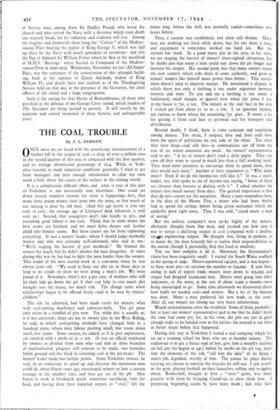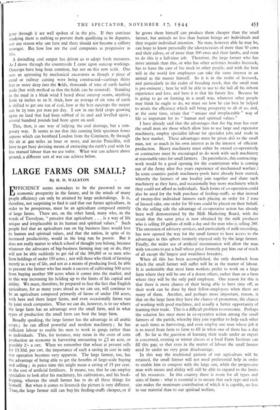THE COAL TROUBLE
By J. L. HODSON ONCE more we are faced with the unwelcome announcement of a further fall in the output of coal—a drop of over a million tons in the second quarter of this year as compared with the first quarter, and an average absenteeism percentage of 12.4. While in York- shire recently to study industrial conditions generally, I tried to get from managers • and men enough information to clear my own mind a little about the causes of the malaise in the mining world.
It is a complicated, difficult affair, and what is true of this part of Yorkshire is not necessarily true elsewhere. One could set down several manifest reasons for what is happening—first, that many lusty young miners have gone into the army, so that much of our mining is done by old men. (And this age factor is true not only of coal ; the average age of Liverpool dock labourers is well over 5o.) Second, that youngsters don't take kindly to pits, and recruiting good labour is not easy. Third, that in some mines the best seams are finished, and we must delve deeper and further afield into thinner seams. But these causes are far from explaining everything. It was a miners' leader, whom I should judge markedly honest and who was certainly well-informed, who said to me: " We're reaping the harvest of past misdeeds." He blamed the owners for much, but he didn't absolve the men altogether. At times during this war he has had to fight the men harder than the owners. This leader of the men started work in a coal-mine when he was eleven years old. " We used to keep our dirt on in those days as long as we could—to show we were doing a man's job. We were proud of it. Nowadays, there's not 4 per cent. of mothers who will let their lads go down the pit if they can help it—too much dirt brought into the house, too much risk. The change came when scholarships began to be offered freely—and to be won by miners' children."
The job, he admitted, had been made easier for miners, what with coal-cutting machinery and conveyor-belts. The pit pony only exists in a handful of pits now. Yet, while this is usually so, it is not universal ; there are ten or twenty pits in the West Riding, he said, in which coal-getting methods• have changed little in a hundred years, where men labour pushing small, low trams down small, low seams. Some owners, he added, as if in part explanation, are satisfied with a profit of 2s. a ton. (It was an official employed by owners as distinct from men who said that in three branches of mechanisation progress still remains to be made, two branches below ground and the third in screening coal at the pit-head.) The miners' leader made two further points. Some Yorkshire owners, he said, in an endeavour to speed up and discover the maximum men could do about fifteen years ago, encouraged miners to hew a certain tonnage in the smallest time, and then get out of the eft. Men began to work at breakneck speed, sometimes sacrificing halts for food, and having done their expected output, or " stint," left the mines long before the shift was normally ended—sometimes two hours before. •
Thus, a custom was established, and often still obtains. Mane men are working too hard while down, but for too short a time, and equipment is sometimes worked too hard too. But the custom has stuck. In a good many pits in his area, in his view, we are reaping the harvest of owners' short-sighted cleverness, but he thinks also that many a man could stay down the pit longer and increase his output. His second point was that many owners resent the new control, which robs them of some authority, and gives to miners' leaders like himself more power than before . This resent- ment doesn't tend to improve output. He mentioned a dispute in which there was only a farthing a ton under argument between masters and men. To you and me a farthing a ton seems a ludicrously small margin to quarrel over when the price,. I pay in my house is 75s. a ton. The miners at the coal face in the area I visited get from about is. to 2S. a ton. I, an ignorant layman, am curious to know where the remaining 73s. goes. It seems a lot for getting it from coal face to pit-head and for transport and distribution.
Beyond doubt, I think, there is some cynicism and scepticism among miners. Too often, I suspect, they and their craft have been the sport of politicians on one side or the other. Too often they have lived—and still live—in communities cut off from the rest of us, where amenities are small. An owners' representative said to. me : " A lot of miners don't read a daily paper. They can earn all they want to spend in much less than a full working week. They need more amenities to encourage them to spend more, then they would earn more." Another of their arguments- is, " Why make more? Even if we do the income-tax will take it." It was a man's, leader, too, who spoke to me of income-tax, saying, " Some of them are cleverer than lawyers at dealing with it." I asked whether the miners save much money these days. The general impression is that they do not—savers are the exception. Many a man remembers how, in the days of the Means Test, .a miner who had been thrifty had to spend his savings before being given -assistance which the unthrifty drew right away. That, I was told, "cured many a man of saving."
But the colliery company's man spoke highly of the miners, obviously thought them fine men, and pointed out how easy it was to notice a declining output in coal compared with a decline, sayijn engineering output. He thought that, living in pockets, as so many do, the men honestly fail to realise their responsibilities to the nation (though I, personally, find this hard to swallow).
You see how complex it all is. Moreover, the Government's vision has been singularly small. I visited the South Wales coalfield in the spring of 1440. Miners numbered 140,000, and it was hoped— so busy were pits—to increase the number to 15o,000. A year later, owing to lack of export trade, miners were down to 105,000, and output had dropped to,000,000 tons. Miners were going into other industries, or the army, at the rate of about 2,000 a month—were being encouraged to go. Some time afterwards we discovered afresh how badly we needed coal—and miners. But a lot of the damage was done. Many a man preferred his new trade, or the army. After all, our miners are among our very finest infantrymen.
Would nationalisation solve the troubles.? Some of them, probably ; but at least one miners' representative said to me that he didn't think the time had come yet, for, in his view, the pits are not in good enough order to be handed over to the nation—he wanted to see them in better shape before that happened.
During this stay in Yorkshire I visited a mil company which has set up a training school for boys who are to become miners. The endeavour is to get a better type of boy, give him a month's training on full pay (he begins at 34s.) before he works on the pit top, teach him the elements of the job, " sell him the idea " of its being a man's job, dignified, worthy of him. The games he plays during training are chosen to exercise the muscles he will use. I saw youths in the gym. playing football on their haunches, rolling and wriggling about. Basket-ball, thought at first a " sissy " game, was made popular with them by bringing Canadiaqs to show them how. A promising beginning seems to have been made ; lads who have gone through it are well spoken of in the pits. If they continue studying there is nothing to prevent thein qualifying to be deputies, nor any reason why one here and there should not become a colliery manager. But how few are the coal companies as progressive as this.
A dwindling coal output has driven us to adopt fresh measures. As I drove through the countryside I came upon outcrop workings. Outcrops have long been common, but not on this new scale. One sees an uprooting by mechanical excavators as though a' piece of canal or railway cutting were being constructed—cuttings thirty feet or more deep into the itelds, thousands of tons of earth hurled aside (but with method so that the fields can be restored). Standing in the mud in a bleak wind I heard about outcrop seams, anything from 19 inches to to ft. thick, how an average of six tons of earth is shifted to get one ton of coal, how at the best outcrops the output can be 25 tons per man per day. I saw in one field crops growing again on land that had been robbed of its coal and levelled again ; several hundred pounds had been spent on seed.
This, then, is one way of helping the coal shortage, but a tem- porary way. It seems to me that this cunning little specimen homo sapiens which can bombard London from the Continent, fly through the air at 40o miles an hour or more, and invent Penicillin, will have to get busy devising means of extracting the earth's coal with far less manual labour than we use today. What war can achieve above ground, a different sort of war can achieve below.



























 Previous page
Previous page